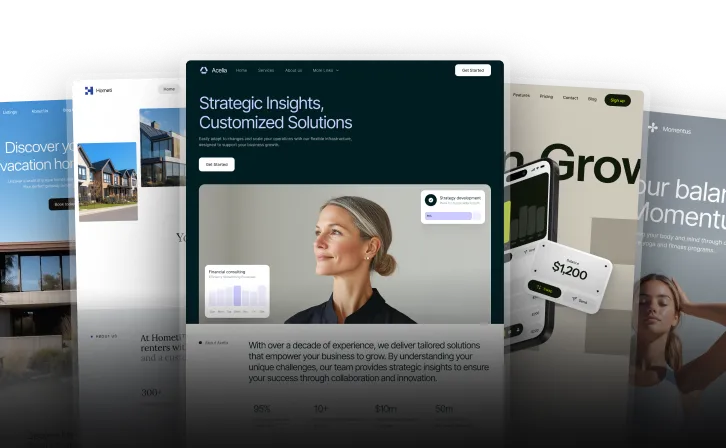Webflow vs WordPress: Which Website Builder is Right for You
Unlock all templates




Choosing between Webflow and WordPress? Here's the quick answer:
- Webflow is best for design-focused projects with a visual, no-code approach. It’s an all-in-one platform with built-in hosting, SEO tools, and direct customer support. Ideal for small to medium websites or e-commerce stores.
- WordPress is perfect for content-heavy sites needing extensive customization. With its open-source flexibility, vast plugin ecosystem, and scalability, it’s great for blogs, large-scale projects, or complex e-commerce needs.
Key Differences at a Glance:
| Feature | Webflow | WordPress |
|---|---|---|
| Platform Type | Closed-source, visual builder | Open-source CMS |
| Ease of Use | Drag-and-drop interface | Requires hosting & setup |
| Design Freedom | Full control without coding | Theme/plugin-dependent |
| Customization | Limited to built-in tools | Extensive with plugins/themes |
| Cost | Fixed monthly plans | Variable (hosting, plugins) |
| Support | Direct customer support | Community resources |
In short, Webflow is for simplicity and speed, while WordPress offers unmatched flexibility and scalability. Your choice depends on your project size, goals, and technical skills.
Getting Started
Webflow Editor Basics

Webflow's visual development platform focuses on design-first functionality through its Designer interface. While the interface offers plenty of tools, it can feel a bit overwhelming for newcomers. You can start with a blank canvas or choose from pre-built templates - ideal for beginners.
The Designer blends drag-and-drop simplicity with advanced design tools. As Ani Duong from LitExtension explains:
"Webflow is well-known as one of the most versatile website builders in the market. However, to unleash the platform's full potential, you need to know how to use it properly."
WordPress Basic Setup

Getting started with WordPress involves a few technical steps. Here's a general outline:
- Hosting Selection: Pick a hosting provider that supports WordPress.
- Domain Connection: Link your domain to your hosting account.
- WordPress Installation: Set up the core files and configure the database.
- Theme Selection: Choose a theme and customize it to fit your style.
- Plugin Setup: Install plugins to add extra features.
With over 56,000 plugins and a wide range of free themes, WordPress offers nearly endless customization options after setup.
Setup Time and Skills Needed
Webflow and WordPress cater to different skill levels and setup needs. Here's a quick comparison:
| Aspect | Webflow | WordPress |
|---|---|---|
| Technical Requirements | Basic design knowledge | Basic hosting and technical knowledge |
| Learning Curve | Visual interface, but tools can overwhelm | Requires understanding of themes/plugins |
| Coding Knowledge | Optional | Helpful to know some HTML/CSS/PHP |
| Design Control | Drag-and-drop with instant feedback | Depends on the chosen theme |
Webflow is a low-code platform, making it user-friendly for both beginners and experienced users. Its visual tools allow you to build professional websites without needing to write much code. On the other hand, WordPress offers more flexibility but comes with a steeper learning curve, especially for customizations involving themes or plugins.
Webflow's backend dashboard simplifies website maintenance. WordPress, however, requires users to get familiar with terms like themes, plugins, and the difference between pages and posts. While both platforms feature visual editors, their design and customization workflows differ greatly.
Wordpress vs Webflow – Full Comparison for Website Builders (2024)
Design Tools
Design control is a key factor in shaping a website's performance and user experience. It directly impacts both how a site looks and how it functions.
Webflow Design Tools
Webflow's visual-first approach gives designers hands-on control. Its Designer interface allows you to tweak almost any element - like text colors or animation effects - using simple point-and-click actions. This makes it easy for teams to quickly implement design updates.
Kyle Johnston, Senior Graphic Designer at HireClix, highlights this benefit:
"We don't need to hire engineers because we have Webflow, which allows us to push our creative limits and elevate our entire web experience."
Webflow also offers a marketplace filled with specialized templates tailored to various industries, including SaaS companies.
WordPress Design Options
WordPress takes a different approach by separating content from design for consistency. Its design capabilities often rely on themes and page builders like Elementor or Divi.
Here are some popular WordPress design solutions:
| Theme/Builder | Key Features | Best For |
|---|---|---|
| SaasLand | Over 60 pre-designed layouts, 4.55-star rating | SaaS businesses |
| Astra | More than 1M active installs | Multi-purpose sites |
| Elementor | Visual editing with pre-made blocks | Custom designs |
For example, the SaasLand theme offers a library of over 60 layouts geared specifically toward SaaS companies. This helps businesses launch quickly while still allowing room for design adjustments.
Design Features Comparison
Webflow and WordPress take distinct approaches to design, and each has its strengths:
| Feature | Webflow | WordPress |
|---|---|---|
| Visual Editing | Built-in editor for direct element manipulation | Requires additional page builders |
| Template Customization | Full control over every detail | Customization depends on the theme or builder used |
| Learning Curve | Can feel complex for beginners due to its feature-rich interface | Varies based on the theme or builder |
| Design Freedom | Advanced customization without coding | Complex changes may need developer assistance |
Elyssa Albert, VP of Design at Attentive, shares her thoughts on Webflow's flexibility:
"The freedom and flexibility we gained through Webflow was invaluable."
Both platforms allow for professional website creation, but they cater to different needs. Webflow stands out for its direct visual control, while WordPress offers a broad range of pre-designed templates, though advanced customization might require extra tools or expertise.
sbb-itb-fdf3c56
Core Features
Webflow Standard Features
Webflow combines design, development, and hosting into one platform. It includes a visual editor, responsive design capabilities, and built-in SEO tools. Accessibility features, like the Vision preview tool, and a hassle-free setup eliminate the need for manual updates or plugin management.
WordPress Plugins and Add-ons
WordPress boasts a massive library of over 60,000 plugins, allowing users to customize their sites extensively. Here are some examples:
| Plugin Type | Popular Options | Primary Use Case |
|---|---|---|
| E-commerce | WooCommerce | Powering online stores (used by nearly 90% of stores in some regions) |
| Digital Products | Easy Digital Downloads | Selling downloadable items |
| Membership | MemberPress | Managing online courses and exclusive content |
| SEO | Yoast SEO | Improving search engine visibility |
While plugins offer plenty of customization options, they may impact site performance and require regular updates.
Feature Set Comparison
Here’s a quick comparison of how the two platforms stack up:
| Feature Category | Webflow | WordPress |
|---|---|---|
| Content Management | Basic CMS with limited categorization | Advanced CMS with tags, categories, and comments |
| SEO Capabilities | Automated tools for optimization | Plugin-based tools with manual control |
| Design Tools | Built-in visual editor | Often requires third-party page builders |
| E-commerce | Native solution (pricing: $29/month to $212/month) | Free WooCommerce with optional paid add-ons |
| Technical Support | Direct customer support | Community forums and extensive documentation |
| Updates | Automatic updates across the platform | Manual updates for core and plugins required |
The choice between Webflow and WordPress depends on your project goals. WordPress provides extensive flexibility and customization, while Webflow focuses on simplicity and design with minimal maintenance.
Site Speed and Safety
Site speed and security play a key role in delivering a smooth user experience.
Webflow Speed and Security
Webflow leverages a dual-CDN setup - Fastly for HTML and AWS Cloudfront for assets - to handle over 2 million requests per second across more than 250 global locations. This setup achieves lightning-fast load times, as low as 0.01 seconds. For instance, Nursa improved its website speed by 70% and achieved a Lighthouse score of 99 after switching to Webflow. On the Enterprise plan, Webflow guarantees 99.99% uptime, with last year’s performance showing only one minute of downtime (99.999% uptime).
Webflow also offers robust security features, including SOC 2 Type I and II certifications, DDoS and bot protection, automatic SSL certificates, two-factor authentication, and automated backups with version control. These features are built directly into the platform, eliminating the need for third-party tools.
In contrast, WordPress requires external plugins and hosting solutions to match these levels of speed and security.
WordPress Speed and Security
WordPress performance depends heavily on the hosting provider and how well the site is optimized. While the platform allows users to choose their hosting setup, this flexibility comes with the responsibility of managing performance and security through third-party plugins. However, poorly maintained plugins can introduce vulnerabilities, which is especially concerning given that 43% of cyberattacks target small businesses.
Performance Metrics
Here’s a breakdown of key performance and security metrics for both platforms:
| Metric | Webflow | WordPress |
|---|---|---|
| Global CDN Coverage | 250+ locations | Varies by hosting provider |
| Average Response Time | 0.01s (10ms) | Depends on hosting and optimization |
| Data Processing | 8TB per hour via CDN | Varies by hosting provider |
| Uptime | 99.99%–99.999% | Varies by hosting provider |
| Security Features | Built-in enterprise-grade protection | Plugin-dependent protection |
| SSL Certificates | Automatically included | Manual setup or provided by host |
| Backup System | Automatic with version control | Requires plugins or host features |
Webflow’s infrastructure is designed to handle heavy workloads, processing 15,000 image uploads and 10 million API requests per hour, with a Lambda function failure rate below 0.001%. Allan Leinwand, Webflow’s Chief Technology Officer, emphasizes:
"At Webflow, our operations are designed with three core principles in mind: availability, security, and performance."
Cost Breakdown
When deciding between Webflow and WordPress, it's important to consider both upfront and ongoing costs, as these will affect your project's long-term budget.
Webflow Pricing
Webflow offers a range of pricing options. Site plans include a free tier and paid plans such as Basic ($14/month), CMS ($23/month), and Business ($39/month). For e-commerce, plans range from Standard ($29/month with a 2% transaction fee) to Advanced ($212/month). Workspace plans, designed for freelancers and agencies, start at $16/month per user and increase for larger teams. Additional features like Optimize, Analyze, and Localization are available as optional add-ons.
WordPress Expenses
With WordPress, costs vary depending on your setup. Expenses typically include domain registration ($12–$70 annually), web hosting ($5–$100/month), SSL certificates ($50–$600 annually), premium themes ($60–$80 one-time), and plugins, which can range from free to thousands of dollars. For a clearer comparison, the key costs are summarized in the table below.
Total Cost Comparison
Here’s a side-by-side look at annual costs:
| Cost Component | Webflow | WordPress |
|---|---|---|
| Basic Website Setup | $168/year (Basic plan) | $35.88–$95.88/year (Hosting) |
| Domain Name | Included in paid plans | $12–$70/year |
| SSL Certificate | Included | $0–$600/year |
| E-commerce Features | $348/year (Standard plan) | Free with WooCommerce |
| Additional Features | $348–$3,588/year (Add-ons) | $0–$1,000/year (Plugins) |
Webflow's pricing structure often means higher upfront costs due to bundled features, while WordPress allows for more control over expenses. However, managing a WordPress site typically requires a more hands-on approach.
Conclusion
This guide highlights the differences between Webflow and WordPress, helping you decide which platform aligns with your needs.
Platform Selection Guide
Choose Webflow if you:
- Need control over visual design.
- Prefer an all-in-one hosted solution.
- Want direct customer support.
- Operate a small to medium digital store.
- Appreciate built-in SEO tools and accessibility features.
Choose WordPress if you:
- Manage content-heavy websites.
- Require extensive customization options.
- Run complex e-commerce operations.
- Need access for multiple users.
- Want flexible budget options.
Here's a quick comparison of the two platforms:
| Aspect | Webflow | WordPress |
|---|---|---|
| Market Share | 0.7% of websites | 43.1% of websites |
| Template Options | 1,450+ templates (50+ free) | 15,300+ themes (5,300+ free) |
| Plugin Ecosystem | Limited third-party options | 59,000+ free plugins |
| Technical Skills | Design-focused approach | Requires development skills |
| Support System | Direct support channels | Community-based resources |
| Cost Structure | Fixed monthly plans | Variable costs based on needs |
Webflow is ideal for quick, design-driven projects, while WordPress excels in customization and scalability. Keep in mind that switching between platforms later can be difficult.
Related Blog Posts
Recommended posts
Unlock all templates







